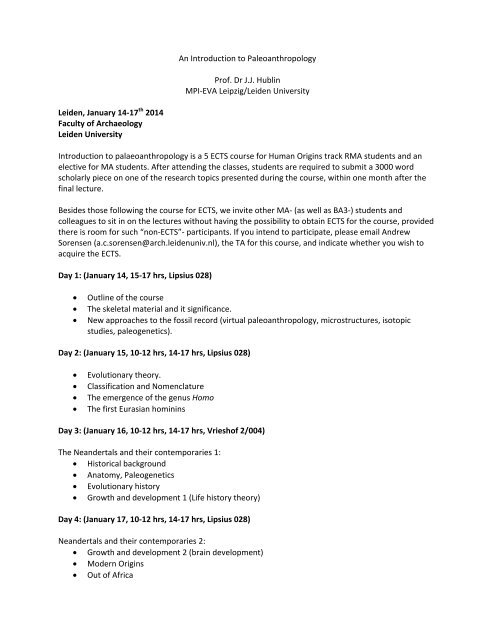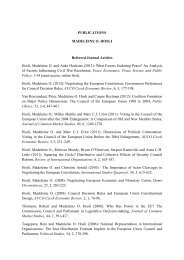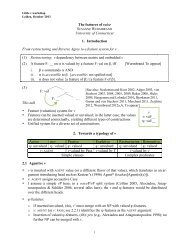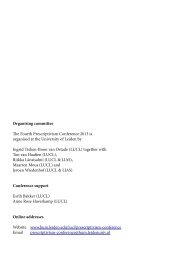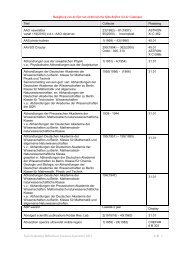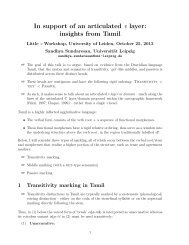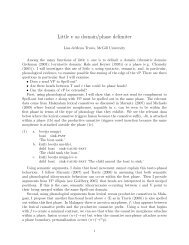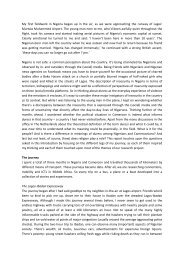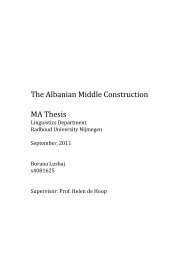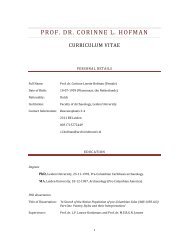Introduction to palaeoanthropology
Introduction to palaeoanthropology
Introduction to palaeoanthropology
You also want an ePaper? Increase the reach of your titles
YUMPU automatically turns print PDFs into web optimized ePapers that Google loves.
An <strong>Introduction</strong> <strong>to</strong> Paleoanthropology<br />
Prof. Dr J.J. Hublin<br />
MPI-EVA Leipzig/Leiden University<br />
Leiden, January 14-17 th 2014<br />
Faculty of Archaeology<br />
Leiden University<br />
<strong>Introduction</strong> <strong>to</strong> <strong>palaeoanthropology</strong> is a 5 ECTS course for Human Origins track RMA students and an<br />
elective for MA students. After attending the classes, students are required <strong>to</strong> submit a 3000 word<br />
scholarly piece on one of the research <strong>to</strong>pics presented during the course, within one month after the<br />
final lecture.<br />
Besides those following the course for ECTS, we invite other MA- (as well as BA3-) students and<br />
colleagues <strong>to</strong> sit in on the lectures without having the possibility <strong>to</strong> obtain ECTS for the course, provided<br />
there is room for such “non-ECTS”- participants. If you intend <strong>to</strong> participate, please email Andrew<br />
Sorensen (a.c.sorensen@arch.leidenuniv.nl), the TA for this course, and indicate whether you wish <strong>to</strong><br />
acquire the ECTS.<br />
Day 1: (January 14, 15-17 hrs, Lipsius 028)<br />
• Outline of the course<br />
• The skeletal material and it significance.<br />
• New approaches <strong>to</strong> the fossil record (virtual paleoanthropology, microstructures, iso<strong>to</strong>pic<br />
studies, paleogenetics).<br />
Day 2: (January 15, 10-12 hrs, 14-17 hrs, Lipsius 028)<br />
• Evolutionary theory.<br />
• Classification and Nomenclature<br />
• The emergence of the genus Homo<br />
• The first Eurasian hominins<br />
Day 3: (January 16, 10-12 hrs, 14-17 hrs, Vrieshof 2/004)<br />
The Neandertals and their contemporaries 1:<br />
• His<strong>to</strong>rical background<br />
• Ana<strong>to</strong>my, Paleogenetics<br />
• Evolutionary his<strong>to</strong>ry<br />
• Growth and development 1 (Life his<strong>to</strong>ry theory)<br />
Day 4: (January 17, 10-12 hrs, 14-17 hrs, Lipsius 028)<br />
Neandertals and their contemporaries 2:<br />
• Growth and development 2 (brain development)<br />
• Modern Origins<br />
• Out of Africa
• Neandertal Extinction<br />
Required reading:<br />
Chapters 5, 6 and 8 in Richard Klein, The Human Career: Human Biological and Cultural Origins, Third<br />
Edition, University of Chicago Press, 2009, ISBN 9780226439655 .<br />
Suggested additional reading:<br />
1. Antón, S. C. and C. C. Swisher (2004) Early Dispersals of Homo from Africa. Annual Review of<br />
Anthropology 33:271-296.<br />
2. Bailey, S., Weaver, T.D. and J.-J. Hublin (2009) Who made the Aurignacian and other early Upper<br />
Paleolithic industries? Journal of Human Evolution 57:11-26.<br />
3. Bruner, E. (2010) Morphological Differences in the Parietal Lobes within the Human Genus: A<br />
Neurofunctional Perspective. Current Anthropology 51(s1): S77-S88.<br />
4. Freidline, S.E., Gunz, P., Harvati, K. and J.-J. Hublin (2012) Middle Pleis<strong>to</strong>cene human facial<br />
morphology in an evolutionary and developmental context. Journal of Human Evolution<br />
63(5):723-740.<br />
5. Froehle, A. W. and S. E. Churchill (2009) Energetic competition between Neandertals and<br />
ana<strong>to</strong>mically modern humans. PaleoAnthropology 2009(96-116).<br />
6. Gunz, P., Neubauer, S., Maureille, B. and J.-J. Hublin (2010) Brain development after birth differs<br />
between Neanderthals and modern humans. Current Biology 20:R921-R922.<br />
7. Henry, A. G., Brooks, A. S. and D. R. Piperno (2011) Microfossils in calculus demonstrate<br />
consumption of plants and cooked foods in Neanderthal diets (Shanidar III, Iraq; Spy I and II,<br />
Belgium). Proceedings of the National Academy of Sciences 108:486-491.<br />
8. Hublin, J. J. (2009) The origin of Neandertals. Proceedings of the National Academy of Sciences<br />
106:16022-16027.<br />
9. Hublin, J.-J. (2012) The earliest modern human colonization of Europe. Proceedings of the<br />
National Academy of Sciences 109(34): 13471-13472.<br />
10. Hublin, J.-J. et al. (2012) Radiocarbon dates from the Grotte du Renne and Saint-Césaire support<br />
a Neandertal origin for the Châtelperronian. Proceedings of the National Academy of Sciences<br />
109(46):18743-18748.<br />
11. Kachel, A.F., Premo, L.S. and J.-J. Hublin (2011) Modeling the effects of weaning age on length of<br />
female reproductive period - Implications for the evolution of human life his<strong>to</strong>ry. American<br />
Journal of Human Biology 23(4):479-487.<br />
12. Kaplan, H. et al. (2000) A theory of human life his<strong>to</strong>ry evolution: Diet, intelligence, and longevity.<br />
Evolutionary Anthropology 9(4): 156-185.
13. Meyer, M. et al. (2012) A High-Coverage Genome Sequence from an Archaic Denisovan<br />
Individual. Science 338(6104):222-226.<br />
14. Neubauer, S. and J.-J. Hublin (2012) The Evolution of Human Brain Development. Evolutionary<br />
Biology 39(4):568-586.<br />
15. Premo, L. S., and J.-J. Hublin (2009) Culture, population structure, and low genetic diversity in<br />
Pleis<strong>to</strong>cene hominins. Proceedings of the National Academy of Sciences 106(1):33-37.<br />
16. Richards, M. P. (2009) Stable Iso<strong>to</strong>pe Evidence for European Upper Paleolithic Human Diets, In:<br />
J.-J. Hublin and M.P. Richards (eds.),The Evolution of Hominin Diets. Integrating Approaches <strong>to</strong><br />
the Study of Palaeolithic Subsistence. Dordrecht: Springer, pp. 251-257.<br />
17. Roebroeks, W., Hublin, J.-J. and K. MacDonald (2011) Continuities and Discontinuities in<br />
Neandertal Presence: A Closer Look at Northwestern Europe. In: N.M. Ash<strong>to</strong>n, S.G. Lewis and<br />
C.B. Stringer (eds.), The Ancient Human Occupation of Britain, Developments in Quaternary<br />
Science. Amsterdam: Elsevier, pp. 113-123.<br />
18. Ruff, C. B. et al. (1997) Body mass and encephalization in Pleis<strong>to</strong>cene Homo. Nature 387: 173-<br />
176.<br />
19. Smith, T. M. et al. (2010) Dental evidence for on<strong>to</strong>genetic differences between modern humans<br />
and Neanderthals. Proceedings of the National Academy of Sciences 107:20923-20928.


